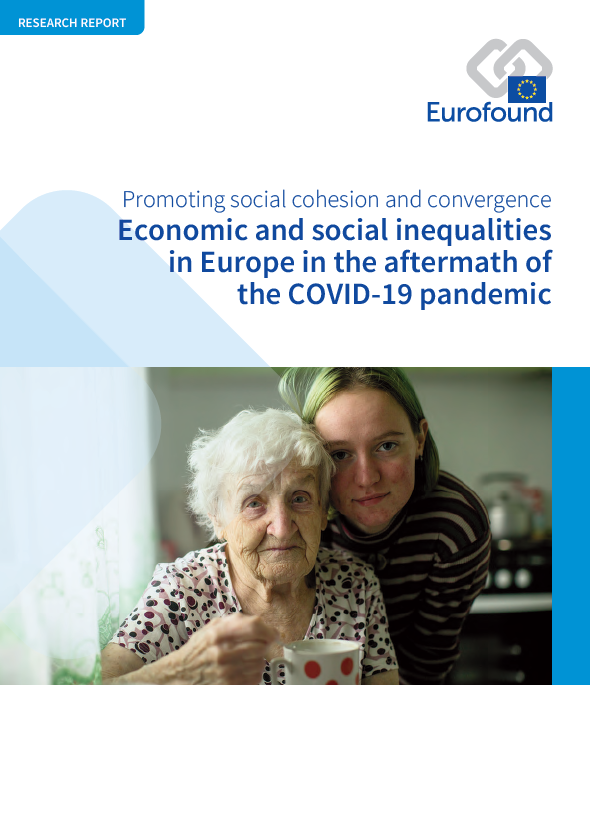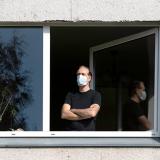
De COVID-19-pandemie heeft, al naargelang de bestaande achterstanden, uiteenlopende gevolgen gehad voor de verschillende groepen in de samenleving. Algemeen wordt ervan uitgegaan dat de ongelijkheid als gevolg van de pandemie op verschillende terreinen is toegenomen. Aan de hand van indicatoren van het multidimensionale monitoringkader voor ongelijkheid (MIMF) van de EU wordt in dit verslag geanalyseerd hoe de ongelijkheid op het gebied van inkomen, gezondheid, werk en onderwijs zich tussen 2010 en 2020 heeft ontwikkeld. Ook worden de belangrijkste oorzaken van deze ontwikkeling tijdens de pandemie onderzocht en wordt er gekeken naar het verband tussen overheidsbeleid en ongelijkheid op verschillende gebieden.
Key findings
In het eerste jaar van de COVID-19-crisis bleef de inkomensongelijkheid dalen, waarmee de afvlakking van de ongelijkheid in de EU doorzet. Vooral werkzoekenden en laag en middelhoog geschoolden werden echter tijdens de pandemie getroffen door een inkomensdaling. De inkomensongelijkheid mag dan over het geheel genomen niet zijn toegenomen tijdens de COVID-19-pandemie, toch is het van cruciaal belang dat beleidsmakers deze groep nauwlettend in de gaten houden gezien de huidige crisis rond de stijgende kosten van levensonderhoud.
Gezondheidsproblemen en inkomensongelijkheid hangen nauw met elkaar samen: mensen met een inkomen in het laagste inkomenskwintiel hebben bijna drie keer zo vaak een handicap als mensen in de hoogste 20-procent-groep. Tijdens de pandemie nam de ongelijkheid tussen inkomensgroepen bij de toegang tot gezondheidszorg toe: in 2020 was het risico op een onvervulde medische behoefte voor mensen met een inkomen in het laagste inkomenskwintiel 5,4 keer zo hoog als in de hoogste 20-procent-groep, wat duidelijk maakt dat beleidsmaatregelen ter vermindering van inkomensongelijkheid ook ongelijkheid op gezondheidsgebied kunnen tegengaan.
Thuiswerken tijdens de pandemie heeft in sommige gevallen geleid tot ongelijkheid tussen lagere en hogere inkomensgroepen, doordat tijdelijke werknemers, jongeren en mensen met onzekere banen kwetsbaarder zijn geworden voor crises. Om ervoor te zorgen dat deze trend in de steeds flexibelere wereld van werk na COVID-19 niet doorzet, zal het voor beleidsmakers van cruciaal belang zijn om onzeker werk aan te pakken en de transparantie en voorspelbaarheid van de arbeidsvoorwaarden te vergroten.
Tijdens de pandemie was de beschikbaarheid van geschikte uitrusting voor online leren belangrijker dan inkomen, wat onderstreept dat de digitale kloof en de toegang tot technologie voor iedereen op lange termijn moeten worden aangepakt. Leerlingen en hun ouders die op het platteland woonden en tijdens deze periode niet hoefden te pendelen, waren ook vaker tevreden over de kwaliteit van online onderwijs dan mensen in de steden.
De mogelijkheid om thuis te werken heeft tot meer ongelijkheid tussen lagere en hogere inkomensgroepen geleid door een verscherping van de genderongelijkheid op het gebied van kinderopvang en huishoudelijk werk. In 2020 zagen vooral alleenstaande moeders zich gedwongen hun werktijd te verminderen als gevolg van de sluiting van scholen en kinderopvang – als vrouwen meer uren onbetaalde zorg blijven verlenen dan mannen, zou dit de loonkloof tussen mannen en vrouwen tijdens het herstel kunnen vergroten.
The report contains the following lists of tables and figures.
List of tables
Table 1: Indicators selected for the income inequality analysis
Table 2: OLS regression model exploring the relationship between government spending and inequality in making ends meet according to education level
Table 3: Panel OLS regression exploring general drivers of income inequality (1995–2020), EU27
Table 4: OLS regression model exploring drivers of income inequality between rural and urban households
Table 5: OLS regression model exploring income inequality by individual characteristics
Table 6: Logistic regressions on income inequality by individual characteristics
Table 7: Indicators selected for the health inequality analysis
Table 8: OLS regression model exploring the relationship between government expenditure and inequality in chronic disease
Table 9: Multilevel logit regression model on worsening health between 2019 and 2020
Table 10: Multilevel logit regression models on worsening health and mental health between 2019 and 2020
Table 11: Indicators selected for the employment inequality analysis
Table 12: OLS regression model exploring the relationship between government expenditure and inequality in opportunity in having a white-collar job
Table 13: OLS regression model exploring the relationship between gender inequality in occupations, childcare and paid leave at country level
Table 14: OLS regression model exploring the relationship between gender inequality in being employed, childcare and paid leave at country level
Table 15: Random effects within–between model showing the relationship between gender inequality in employment, over time and between countries
Table 16: Multilevel linear regression model on the number of hours worked in 2019 and 2020
Table 17: Multilevel linear regression model on the change in the number of hours worked between 2018 and 2019 and between 2019 and 2020
Table 18: Indicators selected for inequality in education analysis
Table 19: OLS regression model exploring the relationship between government spending and inequality in PISA scores
Table 20: Determinants of respondents’ satisfaction with the quality of their children’s online schooling (multilevel ordered logit model)
List of figures
Figure 1: Dimensions of life of the EU MIMF
Figure 2: Intersectional approach to effects of COVID-19 on inequality
Figure 3: Macro-, meso- and micro-level factors in income inequality during the COVID-19 pandemic
Figure 4: Heatmap showing the results of income inequality indicators by country, 2018–2019, EU27 and the UK
Figure 5: Income quintile share ratio (S80/S20) for equivalised disposable income, EU27
Figure 6: Gini coefficient of equivalised disposable income, EU27, Bulgaria, Greece and Poland
Figure 7: Odds ratio of a household having problems making ends meet (with versus without a tertiary education, 2018) against spending on education (2015, % of GDP), EU27 and the UK
Figure 8: Odds ratio of a household having problems making ends meet (with versus without a tertiary education, 2018) against spending on social protection (2015, % of GDP), EU27 and the UK
Figure 9: Scatterplot of government spending on social protection (% of GDP at time t–1) relative to the Gini index of disposable income at time t (1995–2020), EU27
Figure 10: Odds ratio of households having problems making ends meet (rural versus urban, 2018) against public investments in agricultural R&D (2015, % of GDP), EU27 and the UK
Figure 11: Households that reported that their income decreased in 2020 compared with the previous year by country (%), selected Member States
Figure 12: Households containing people aged 50+ that received financial support from the government due to the pandemic by country (%), selected European countries
Figure 13: Recipients of pandemic-related government support by country, EU27 (%)
Figure 14: Macro-, meso- and micro-level factors in health inequality during the COVID-19 pandemic
Figure 15: Heatmap presenting the results of health inequality indicators, 2018–2019, EU27 and the UK
Figure 16: Map of odds ratios of people reporting unmet medical care needs (women versus men, adjusted), 2018
Figure 17: Heatmap of odds ratio of feeling depressed for different social groups, 2018–2019, EU27 and the UK
Figure 18: Risk ratios of having a severe long-standing limitation in usual activities (disability) due to a health problem for various social groups (2010–2020), EU27
Figure 19: Risk ratios of having an unmet medical need due to high cost, distance to travel or waiting lists for various social groups (2010–2020), EU27
Figure 20: Government spending on education in 2002 (% of GDP) relative to ex ante inequality of opportunity in having two or more chronic diseases in 2019 (aged 50+), EU27
Figure 21: Macro-, meso- and micro-level factors in inequality in working life outcomes during the COVID-19 pandemic
Figure 22: Heatmap showing results of working life inequality indicators, 2018–2019, EU27 and the UK
Figure 23: Risk ratios of gender inequality in various dimensions of working life (2002–2020), EU27
Figure 24: Risk ratios of unemployment rates among various social groups (2002–2020), EU27
Figure 25: Risk ratios of employment rates among various social groups (2002–2020), EU27
Figure 26: Odds ratio of women being in employment versus men (2019) against the share of children under three years of age in formal childcare (2019, %), EU27
Figure 27: Average number of weekly hours worked in 2020 by country and contract type, selected EU Member States
Figure 28: Proportion of women who held second or third jobs by household type, 2020 (%)
Figure 29: Macro-, meso- and micro-level factors in inequality in education and learning during the COVID-19 pandemic
Figure 30: Heatmap showing results of education inequality indicators, 2018–2019, EU27 and the UK
Figure 31: Difference in tertiary education attainment as a whole in 55- to 74-year-olds and those with parents with a lower than tertiary education (2021)
Figure 32: Trends regarding inequality in education between women and men (2002–2020), EU27
Figure 33: Risk and odds ratios of NEET rates between various social groups (2004–2020), EU27
Figure 34: Government spending on education (2013, % of GDP) against P90/P10 PISA scores in mathematics (2018), EU27 and the UK
Figure 35: Parents’ satisfaction with the quality of online schooling for their children, EU27 (%)
Figure 36: Parents’ satisfaction with the quality of their children’s online schooling depending on whether they worked from home or not during the pandemic, EU27 (%)
- Number of pages
-
102
- Reference nº
-
EF22002
- ISBN
-
978-92-897-2309-1
- Catalogue nº
-
TJ-07-23-019-EN-N
- DOI
-
10.2806/439913
- Permalink
Cite this publication
Eurofound (2023), Economic and social inequalities in Europe in the aftermath of the COVID-19 pandemic, Publications Office of the European Union, Luxembourg.
